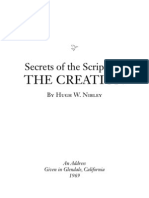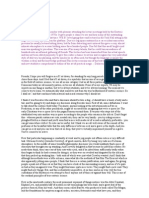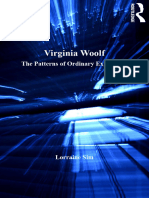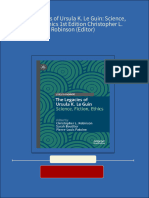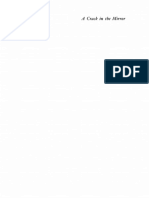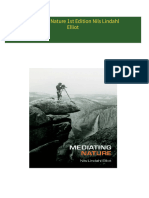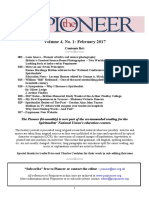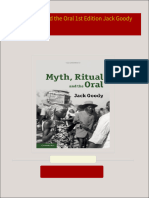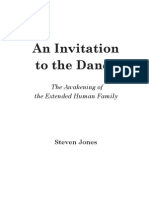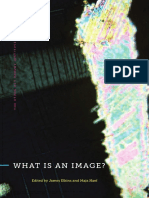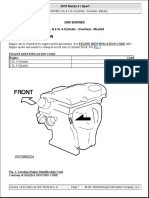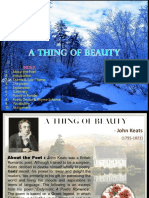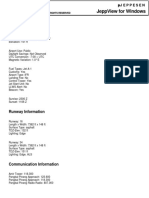0 ratings0% found this document useful (0 votes)
91 viewsCrop Circles
Crop Circles
Uploaded by
Ibon LemuraLucy Pringle
Copyright:
© All Rights Reserved
Available Formats
Download as PDF, TXT or read online from Scribd
Crop Circles
Crop Circles
Uploaded by
Ibon Lemura0 ratings0% found this document useful (0 votes)
91 views42 pagesLucy Pringle
Original Title
Crop circles
Copyright
© © All Rights Reserved
Available Formats
PDF, TXT or read online from Scribd
Share this document
Did you find this document useful?
Is this content inappropriate?
Lucy Pringle
Copyright:
© All Rights Reserved
Available Formats
Download as PDF, TXT or read online from Scribd
Download as pdf or txt
0 ratings0% found this document useful (0 votes)
91 views42 pagesCrop Circles
Crop Circles
Uploaded by
Ibon LemuraLucy Pringle
Copyright:
© All Rights Reserved
Available Formats
Download as PDF, TXT or read online from Scribd
Download as pdf or txt
You are on page 1of 42
forty-five.
com / papers / 144
Crop Circles: Windows of
Perception
Lucy Pringle The following text is based on a lecture by internationally
Reviewed by Ellen R. Hartman
renowned crop circle authority Lucy Pringle, delivered on
October 28, 2015, at the Sullivan Galleries, School of the
Art Institute of Chicago.
Moderator: Ben Nicholson
This series of three talks is by people who are working beyond
the edge of design. The series is called Taboo Subjects,
meaning subjects that are not really thought about very
much within the design and the architecture and the arts
community.
This evening’s lecture is being given by Lucy Pringle. She
was educated in England and France and Switzerland and
is a member of the Center for Crop Circle Studies, and a
pioneer researcher into the effects of electromagnetic
fields on living systems. This includes the physiological and
psychological effects reported by people after visiting and
being in the vicinity of a crop formation. She also studies
animal behavior, remote effects, luminosities, mechanical
failures and audio effects. Within our discipline of arts and
design and architecture, these are things that we desire so
much to have access to and yet know so little about.
Lucy Pringle works with scientists from all over the world
and was one of the speakers at the Institute of Science
and Astrophysics in Sofia, Bulgaria. The BBC has recently
produced a program on her research, and she has appeared
on the Discovery, Learning, and History Channels, as
well as TV programs in Germany, Japan, France, Italy,
Spain, Slovenia, Mexico, and Canada, as well as the BBC
World Series. The BBC does not yet broadcast to the outer
atmospheres, so we are going to be just working on the world
today. That’s an English joke.
Lucy is a founding member and the chairman of the
Unexplained Phenomena Research Society, as well as a
member of the British Society of Dowsers, and she lectures
at home as well as internationally. She has lectured at
Christ College, Cambridge, at the Darwin Society, the
Scientific Exploration Society, and the College of Psychic
Studies and Alternatives in London. She has three books to
her name, and her latest book is on... Forgive me, Lucy, I
cannot remember the title of the new book but it’s about crop
circles. They’re all out of print.
This afternoon we will be taken into a place that is familiar
to some and probably deeply unfamiliar to others. Human
beings have the ability to have cognizance of qualities within
our world, within our being, that has been, what you might
say, culturally edited out. Lucy, this evening, is here to
bring these qualities back. So please welcome Lucy Pringle.
Lucy Pringle
Thank you for that glowing report. Also, thank you for
inviting me here. I feel very honored. I’ve spoken at several
Uffington, Oxfordshire, July 8, 2006
Photo © Lucy Pringle
places in America, but never in Chicago, so this is a new
adventure for me.
This is a huge subject, and whatever I’m going to tell
you tonight, I’m literally only going to be scratching the
surface.
We’re going to start with one of the oldest images, if you
like, because this is not a new phenomenon. This is a very
famous one. It’s the Mowing Devil. It is a woodcut because
in those days they didn’t have photography or anything like
that. It dates to 1678. It tells the story of a farmer in
Hertfordshire who had a field of oats. And when they were
ready to be harvested, he called in a reaper.
Well, apparently that man was going to charge such a huge
amount of money that the farmer was heard to say that he
would rather the devil took his oats. And that is why this is
called the Mowing Devil. Now, the farmer went away, and
during the night, apparently, he heard strange sounds and
he saw strange lights. And this is extraordinarily similar
to what is happening in the fields today. We see these
luminosities or lights hovering about the fields. And very
often, if you go into that particular field the next morning,
you may well find a crop circle underneath where you saw the
lights the previous night.
When he came back the next day, he found part of his crop
laid down in round circles and apparently he was terrified.
But this is quite a misleading slide, because you can see
that supposedly, the Mowing Devil, there he is, is cutting
the crop. This is such a famous one that everyone thinks
that in genuine crop circles that the crop is actually cut at
the base. It’s not. It’s bent over very, very, very gently. No
damage to the crop whatsoever.
Now, he wasn’t the very first person to talk about crop
circles. Very recently I found a piece about John Aubrey.
John Aubrey was an antiquarian historian and a philosopher,
and he lived from 1626 to I think 1676. He, together with
William Stukeley, were the two people to record what was
happening at Stonehenge and Avebury in those days. We owe
them a huge, huge debt, because but for them we would have
no record of these very historic, sacred places at all.
He was also fascinated in the round grass circles that he
was finding on the Wiltshire Downs, and this is what he
wrote: “I presume they’re generated from the breathing out
of a fertile subterraneous vapour.” Little did he know that,
400 years later, he would have found a very important part
of the jigsaw puzzle.
Many people say to me, what is this subject all about?
What is the meaning behind all this? I received an email
from someone who said she had been looking at the pictures
in my book, and she said they had had a profound effect
on her. They’re all giving off—later on, as you’ll see the
actual pictures of the formations—they’re all giving off
frequencies.
[Slide disappears due to unexpected technical failure.]
"The mowing-Devil, or, Strange news out of Hartford-Shire," woodcut, 1678
Photo courtesy Folger Shakespere Library
Strange things often happen when I talk about crop circles.
There’s a sort of strange energy around and the most
mysterious things happen. The most reliable technology
fails.
What was interesting—she said that a word that came
into her mind was “didactic,” and she didn’t know what
“didactic” meant. So she looked it up in the dictionary and
in fact I heard Kate use the word yesterday, and this is what
she found in the... [Slide reappears.] Here we are. Hooray.
Hip hip hooray. “Designed or intended to teach, intended to
convey instruction and information, as well as pleasure and
entertainment.” I think that actually fits the bill very, very
precisely with this phenomenon.
Strange things do happen in circles. Many people like to
meditate, because it’s an extraordinary event they are
experiencing: it has a draw to the right-hand side of your
brain. When I do my scientific work, I really rebel against
it. I want to be sitting there meditating, but I have to sort
of discipline myself to the scientific aspect.
This was a wonderful one. This appeared in 1993. It’s called
Bythorn. It’s got so much symbology: the five-pointed star
of Shiva and all the rest. Shiva was androgynous, etc. I
won’t go into that. The group were sitting meditating around
the edge of this circle, and one of the women heard someone
walk up behind her when they were meditating, and she went
on with her meditation. When it was finished, she was too
embarrassed to say anything. Like so many people, she
thought maybe she had imagined it.
But the man sitting next to her said, “Where is the person
who walked up behind us?” No one else had joined the circle.
I’d like to think of it as the genius loci, the guardian of the
spirit, if you like—of the place; maybe the guardian of the
crop circle. This has happened time and time again.
I’m going to take you back now to 25 years to 1990, because
this year is the anniversary, really, of the very first
amazing crop circle to appear. Before this, we had simple
single circles, and then we’d had a ring around them, then
more rings. Next we had little satellite circles which we
call “grapeshot.” Suddenly we had this extraordinary
event appear with a shaft connecting all these elements,
and we had these abutments coming off, which scholars of
the arcane, they likened them to all different schools of
mystery.
It set the world alight. So many people went in. All over
the world they came to visit it. I think I was one of the few
people who didn’t go in. Why I didn’t, I don’t know. Maybe
I wasn’t meant to go in. But it created a huge stir. As Ben
[Nicholson] was saying, this was the year we started the
first academic society, which was called the Center for Crop
Circle Studies.
The whole thing took off. Our president and secretary were
both very polished public speakers. They did a lot of
forty-five.com / papers / 144 television work; they did a lot of radio broadcasts. The
whole thing went wild, went viral, all over the world.
Suddenly the powers that be got worried. The next thing that
happened was that Doug and Dave appeared.
I remember this very well because I had an organized a
lecture in Farnham, and the place was thronged with people.
Suddenly this news broke, and again, just like everything
else to do with crop circles, it made headline news—
America, everywhere, all over the world. There wasn’t a
phenomenon anymore; there wasn’t a mystery. These two
men were responsible for everything.
For many people, they clutched to this rather like a dying
man will clutch at a straw. Thank goodness, they said,
we’ve now got an answer. Because so many people, if they
can’t find an explanation to it, they become very scared.
Other people said, no, that’s not true. There were circles
happening in Europe at that time. Doug and Dave had nothing
to do with those. They said they only did ones in Hampshire,
and indeed, they did do simple ones in Hampshire.
But even today, when people introduce me and say, “Oh,
she’s working in crop circles,” “Crop circles? But they’re
all man-made! Those two old boys made them. We know all
about it. There’s no phenomenon at all”—it’s extraordinary
how that caught on.
Well, they were very careful. They learned their lines very
well, Doug in particular. If you got them—because they did
several lectures—if you got them both in the same room,
Doug at one end and Dave at the other, and you asked them
identical questions, you got completely diametrically
different answers. So Dave was packed off to Australia. He
couldn’t get his lines right. Sadly, he became an alcoholic,
and he died.
I remember one program I was doing with the BBC, and a
colleague of mine had already been caught out, so I was
wary. They took me into a new circle, and they asked, “What
is your opinion of this?” It was a mature crop, and I looked
at it very carefully. I felt it between my thumb and finger,
and it was crushed. I looked underneath, and there were
seeds underneath—i.e., pressure had been exerted onto the
fallen crop.
So I said to the producer, “Well, either this is man-made
or else people have been in it. I don’t know which.” And
they said, “Doug made it this morning.” It was a very, very
simple circle. Anyhow, my bacon was saved.
In those days, the farmers were very, very happy to let you
into their fields. In fact, they often came with you. They
were thrilled. But ot anymore. Nowadays, the farmers are
shutting their fields, and some of them are actually going in
and just harvesting straight through a circle, cutting it in
half.
There’s one man, Tim Carson, who actually owned the field
where that enormous one appeared. He’s had over a
Martinsell Hill, Wiltshire, July 19, 2007
Photo © Lucy Pringle
forty-five.com / papers / 144 hundred on his land. And the trouble is, this has become
a commercial phenomenon. People come from all over the
world—from the Far East, Middle Europe, Europe, America,
Canada. Everywhere. And they appear in these huge buses,
and they’ll just peel out and they’ll go in wherever. They get
so excited. They actually forget it’s the farmer’s field. It’s
his livelihood. And they’ll go in straight across the crop.
And someone else will go in straight across that way. And
once these paths are made, everyone else will go in. And, of
course, the farmers get very upset.
So, it has become quite a problem. It was a huge commercial
enterprise for that particular area in Wiltshire. I think they
were making something like six million pounds a year, which
would be about $10 million, due to the crop circles, and now
all of that’s going. But still, the circles are there.
Now, people say, in what do these appear? Well, they will
appear in anything which will take an imprint. And this one
dates back to the 1980s. It appeared in Lincolnshire in a
field of potatoes, and the farmer did extensive research.
There was no plant decay; there was no soil deficiency;
and no tracks leading to or away from it. So far as he was
concerned, there was no explanation.
There was also an extraordinary story given to me by
someone called Andre Tong, who I went to visit in Kent. As a
young lad, he had been working on a farm, and one morning
he and the farmer went into a field of sprouts. It was a very,
very frosty morning. And to their amazement, they found
this huge flattened area of sprouts.
The strange thing was, there was no frost whatsoever in the
circle. There was a dead pheasant lying on top, and there
was no frost on that either. Now, we know that there is a
change of temperature, a change of atmosphere, in these
circles, but that was an extraordinary explanation of that
precise happening.
Also, what is particularly interesting is that in canola—and
I’m going to be showing you pictures of the canola... It’s a
hollow-stem crop, and it’s fragile. And if you bend it at an
angle of more than 40 degrees, it snaps.
Well, sprouts have a far greater diameter, and so they will
snap far more easily. They weren’t snapped at all. They were
just softened at the base, lying flat.
Another question is, when does this phenomenon appear?
Well, the answer is, we don’t know. The sort of general
hypothesis is that it originates in the ionosphere, which is
an area of huge atmospheric electricity, and then it spirals,
this electric force, to earth, and it’s been estimated that
it hits the ground with hundreds of thousands of volts per
meter, but only for a nanosecond; otherwise it would burn
the crop. And very occasionally, we do see evidence of
scorched crop on the fallen crop inside a circle. But the
answer is, we really don’t know.
Now, talking about the press, there’s a huge embargo on
this subject. There was an article I had submiited for and
Wheat at Etchilhampton, nr Devises, Wiltshire
Photo © Lucy Pringle
Wheat at Silbury Hill, nr Avebury, Wiltshire
Photo © Lucy Pringle
The Jaw-Dropper, Milk Hill, Wiltshire, August 14, 2001
Photo © Lucy Pringle
was submitted by a news agency just before I left. Not a
single paper or magazine anywhere in the world would touch
it, because it was to do with making this into a credible
subject, and they don’t want that.
How do you feel about the National Geographic? Do you feel
it’s a reputable, well researched magazine? Yes? So did
I. It was one of the ones we were allowed at school. It was
a really genuinely good educational magazine. Well, all I
can tell you is, when I have done...certainly one program
with them, and I can’t tell you what a disaster it was. They
told me no one else would be involved, and yet at the end, I
was given half a minute’s coverage and the hoaxers were
given two and a half minutes, and the hoaxers weren’t even
supposed to be involved.
Well, they came to about six or seven of us researchers from
all over the world—America, Belgium, all over—saying they
wanted to do a program on the circles, and we all said no.
We’d all had bad experiences with the National Geographic.
Several years ago, Bert Jansen from Belgium was walking
past Silbury Hill one night at about midnight, and he saw
across the road, at West Kennet Long Barrow, a whole lot of
lights, and he thought he’d go up and investigate. He found
a film crew there, so he went up to the producer and asked
what was going on. She said, “Oh, we’re making a film for
the National Geographic on people making a circle.” So Bert
thought, oh, that’s interesting. So he went over to where
these men were with their stomping boards, their great, big
planks, and they sort of walked and pressed the crop down
into the ground.
To his absolute amazement, he found they weren’t making a
circle; they were actually walking around a circle that had
appeared two weeks before. Now, the way that was shot, the
whole world believed that those men had made that circle.
We tried to get to the bottom of this; we tried to follow it up.
We followed it all the way up to a head office in America. We
met an absolute stone wall.
So this is what’s happening. What are people frightened
of? What pressure is being put on them? Either way, I know
that my telephone is tapped and I really couldn’t care less,
because—[laughs]—I’m just devoted to this work.
Now, this was one...The hoaxers sometimes like to claim
everything, sometimes as many as six different groups,
all quite independent, will claim the same one when none
of them have done it at all. This was one that they actually
wrote to me and said they couldn’t do. It was called the
Jaw-Dropper because it was huge. It was 409 circles, and
it almost covered the entire width of the field.
They said that, due to the hours of darkness at night at that
particular time of year, the size and number of circles, and
the fact they would have had to have created a circle every
thirty seconds, “We can’t do it,” they said. So, in the book
I’ve got there, I have actually included that because I
thought, well, that’s really honest.
Pitt, nr Winchester, Hampshire, August 15, 2002
Photo © Lucy Pringle
Another thing that was particularly interesting about this
one was that it was raining that night when it occurred.
Now, if you walked on the tram lines—these are the lines
in between the crops that the farmers use for spraying
and cultivating and that sort of thing—and if it has been
raining, you build up a whole lot of soil on the soles of your
feet. Sometimes it’s almost like walking on stilts and you
have to kick it off.
If you then go into the field with stomping boards and you’re
walking into the standing crop, you’re bound to get mud
on the fallen crop. I have seen ones where there has been
a thin film of mud. There wasn’t a trace of mud on any of
those circles. And it’s a fractal image. It’s absolutely
incredible. Many strange things happened in there—
electrical failures.
I do say to people, if they don’t feel well as they’re
approaching a circle or, actually, when they’re inside a
circle, for goodness sakes come out, because there’s a
whole gamut of effects that you can go through. Certainly,
due to the electrical failures, I get worried if people have
got health devices which are geared by a battery like a
pacemaker. I think they’re much improved now, but I always
say, go to your doctor and check that you’re going to be all
right if you’re going to come with me on one of my tours—
[laughs]—because I don’t want people collapsing all over
the place.
And this was another one they said they couldn’t make. This
happened at Crabwood in 2002. It’s rather like a computer-
generated image. You could probably do it on a computer,
but how the heck are you going to put that in the field in the
middle of the night? It’s quite extraordinary. All I can
tell you—when I was flying over it, it meant absolutely
nothing to me at all, and I thought, well, this is a most
extraordinary thing.
So I said to the pilot, “Let’s orbit around it and see if it
makes any sense.” In those days I was still using film in
my camera, and I took it down to the printers, and as this
thing came out we both said, “Ah! That’s a face.” It was
absolutely stunning. But you then get this disk, and it’s as
though you’ve got two master artists at work, two different
artists.
What is so extraordinary about this one? This is the disk.
Now, this disk is comprised of little tufts of crop. As you
walk around something, you see it in different perspectives.
But the reality always stays the same. For instance, if
you’re walking around a chair, you’ll see the chair in all
different perspectives, but the reality is that it is still a
chair. What was even more extraordinary was that there
was a decoded message in here. This was worked out by
Paul Vigay, who was a close friend of mine. Sadly, he died a
couple of years ago.
forty-five.com / papers / 144 Using the ASCII character set and binary, this was what he
deciphered, and some was in upper-case, some in lower-
case:
Beware the bearers of FALSE gifts & their BROKEN PROMISES.
Much PAIN but still time. BELIEVE. There is GOOD out there.
We oppose DECEPTION. Conduit CLOSING.
Pitt, nr Winchester, Hampshire, August 15, 2002
Photo © Lucy Pringle
Now, to find that message from little tufts of crop is
unbelievably bizarre. But also, I thought that it was really
quite a superficial message. To me, it was what you would
call a steganogram, which is a code within a code. And I
happened to go to a talk about the Omega file a few years
later, and there were one or two people there who had
actually worked at Bletchley, decoders at Bletchley. So I
gave this to them. None of them have so far managed to come
up with a steganogram. But it’s just an amazing piece of
work. Paul was absolutely brilliant.
This is the one I call the Doubt Dispeller. It looks like
absolutely nothing. It’s in a field of barley, and it was
early in the year, because there you have the canola in the
background. It was flattened three feet off the ground.
No way could any pressure have been exerted on that
whatsoever. It was all twisted and bent. None of this was
broken. It was like spiders’ webs in places. All of it was just
bent over. It has a most curious effect.
Many of the skeptics said, “Oh, that’s just rook damage.”
So I went and spoke to the farmer and he said, “I have
a rookery, and I’m going to show you what rook damage
looks like.” So off we went, and it looked nothing like that
whatsoever. He said, “That’s not rook damage.” He was
absolutely, completely perplexed. He could not find an
answer. (Rooks are birds!)
I was doing a lot of work, and still do, with someone called
Christopher Weeks. We were walking down the tram line, and
there were telegraph poles. And, on the right-hand side,
we came upon another circle with exactly the same effect:
again, flattened, three feet off the ground. It had a very
sharp cutoff point there. We thought, well, that’s very
strange.
We walked a little bit further, and we found that bit. So I got
out our measuring tape. We measured it. That was exactly
22 feet, and that was exactly 22 feet. So clearly there was
a descending force which in some way met the electricity
of the telegraph poles and got sliced at that particular
juncture.
Now, the first crop—this was actually one that appeared
in 2010, again, in canola. And as I was saying, it’s the
easiest crop to find out if it’s genuine or not because any
weight that is exerted on it, it does massive damage. And
Prometheus, which produces the programs Ancient Aliens—I
don’t know if any of you know that—they wanted to do a
program on crop circles, and they rang through. They didn’t
really know too much about them, but they’re a really nice
bunch of people, and I spent hours talking to them about it.
They wanted the best hoaxers to construct a circle identical
to one that had already appeared, which was perfect. This
one was perfect. Again, it was in canola. I went in. There
was no damage whatsoever. So this was the one that was
selected. They asked me to get in touch with the hoaxers
and arrange for it then and go in as the critical person
afterwards to give my opinion.
Well, I can tell you, they’re not a very nice bunch of people.
I knew they wouldn’t be able to do it, and then I would have
had to pull all their work to pieces. I thought, well, I don’t
think I want to do that. And someone called Charlie Mallett
took it over.
This is their effort. It was extremely good, as you can
see. I flew over it, because Charlie wanted me to take a
picture of it when it was being made or almost completed.
Now, this was in another pilot’s airspace, and you have to
ask permission to fly fairly low if you want to go into their
airspace. We couldn’t get ahold of him.
forty-five.com / papers / 144 So this was taken from about a quarter of a mile above the
earth, above the ground. And I’ve just got a particularly
good lens. It was a very expensive lens, and I had to sell a
really beautiful, old, silver coffee-pot in order to buy that
lens. Luckily, my sister bought it, so it’s still in the family.
Here you can see their ladder down at the bottom of the field,
and there they are holding a tape across. There are two
people there holding a tape across the other one.
The tape there will be knocking off the flowers. Well,
afterwards—I’ll zoom in again; there you can see it more
clearly—there they are. Well, when we went in—well,
Charlie went in first and then I went in later—all I can
say is I really took my hat off to them because if ever you
have walked through a field of canola when it’s ripe, it is
absolutely horrendous. The pollen gets everywhere. It gets
in your hair, in your nose, in your eyes, in your ears. You’re
covered in yellow. The smell is awful. And they worked on
that for about four hours.
And here you can see, there is a broken stem at the base.
There is another one. There is a crushed stem. And there
is a bruised stem. They can’t do it. They just cannot do it.
Now, this is really good. Prometheus is actually going to
show this. It’s come out in the States. It’s come out here
already, but it hasn’t been released, I don’t think, in
England yet. So this is a really valuable piece of work.
This is the genuine one. I went in on—into a formation very,
very early one morning. Again, it had been raining. And
what I had to do was to dig right under the base. I always go
around the perimeter, because that’s where fewer people
have walked. And I found this one. And you have to dig quite a
bit around it, because, even if it’s cracked underneath, then
it’s not right. And that was perfect. But it was so muddy, I
can’t tell you. I was covered in mud, my camera was covered
in mud, I was a total mess. But that was a very worthwhile
photograph.
And I was supposed to do a three-hour interview with
Prometheus. The production company did a lot of thinking.
Well, they thought. They thought some more. There’s the
producer doing a lot of thinking. And even more thinking. And
then, suddenly, a little light aircraft came over and decided
to loop-the-loop and do acrobatics. So I ended up by doing
an interview of about twenty minutes, which was totally
interrupted, so in fact nothing happened at all. But I think
Charlie Mallett did, because he had them down in Wiltshire
for three days. I think he did a really good interview.
Now, we’ve simply got to—we can’t possibly not tell this
story, because this is an eye witness account of a formation
that happened, actually, in the daytime. And I had been
giving a talk at Alton College in Hampshire and someone went
in a taxi afterwards and said to the taxi driver, “Oh, I’ve
just been to a fascinating talk on crop circles.” And the taxi
driver said, “Ooh, I saw one appear at Stonehenge.”
So this got back to me very quickly, and I rang through to the
taxi driver and I said, “There isn’t one at Stonehenge at
The “Spider’s Web,” Avebury, Wiltshire, August 10/11, 1994
Photo © Lucy Pringle
forty-five.com / papers / 144 the moment—one that I know about. Can you possibly tell me
where it is?” And she said, “No, no, it’s years ago.” So at
that time, I said, “Well, there was one in 1996, one in 1997,
and one in 2002.” She immediately said 1996, because that
was the year a son who was in the army was on leave. And
she said, “I know it was a Sunday” because she had to drive
down the A303, which is one of the most clogged roads going
to the west, and all the evening traffic was coming back
after the weekend, and she had a clear run.
As she was coming down the hill from Amesbury—you can see
Stonehenge on the right—she saw this curious cloud hovering
above the field on the left, and there was a whole mass
of cars pulled in to the side, on the verge. One came out,
so she nipped in quickly, and she thought, “I wonder what
everybody’s doing looking over the fence.”
So she joined them, and she said she saw the most amazing
thing. She saw the crop actually going down in front of her
eyes. And it got bigger and it got bigger and it got bigger.
She couldn’t see the shape because she was on the same
plane, but she said what she was witnessing was just
unbelievable. And she said, “Something happened to be
happening to the mist. They weren’t actually joined, but they
seemed to be communicating in some way, because the mist
was also expanding and circling around as the crop, on the
ground, was so expanding.
So I said to her, “Well, how long do you think this took?”
And she was one of the most factual people I’ve ever come
across. She was Irish. And she said, “Well, Lucy, when
you’re watching something like that, you’re not looking at
your watch, are you?” So I said, “No. No, of course you
wouldn’t. I wouldn’t be, either.” I said, “No, of course
not.”
So then I pressed her, because all the other reports I’d
had, which I wrote up in my first book, it happened in a
matter of seconds. And so she said, “I think it was between
20 and 25 minutes.” I said, “Are you sure?” And she got
really quite cross with me. She said, “Lucy, I was there. I
know what I saw. You weren’t there. You don’t know what I
saw.” [Laughs.] No arguing with that whatsoever. So I went
away feeling really quite chastened, but also really very
disappointed, because I thought, well, she was so credible,
but she’s simply got all this wrong.
And then I thought again. A little bit further again. I
thought to myself, hold on. All the other eyewitness stories
I had recorded were about simple, single circles, and
here we’ve got something which is gigantic. It had 501
circles. So I got in touch with Jim Lyons, with whom I do a
huge amount of work. He was chief engineer at the British
Aerospace when they were developing the Harrier Jump Jet.
He’s an academic through and through. He’s now retired,
so he’s free to think and do whatever he wants. He’s really
a polymath, and he puts up with my total ignorance about
basic science.
Windmill Hill, nr Avebury Trusloe, Wiltshire, July 18, 2002
Photo © Lucy Pringle
Woodborough, nr Alton Barnes, Wiltshire, August 13, 2000
Photo © Lucy Pringle
And so I told him about this, and he got wildly excited about
the mist. He said, “This is part of the forming process.”
And so I said, “But listen, Jim, what about this time
element? Would there be any difference?” And he said,
“Yes, of course. Just give me the number of circles and the
measurements and I will tell you how long it takes to form.”
Well, in those days we did have teams of people going out
measuring the circles. Sadly, now, I think I’m about the only
person doing work in England on the circles. We badly need
more people. Anyhow, he wrote back, and I’m going to read
you what he said.
It’s generally accepted that, as a result of work conducted
in the 1990s, it’s possible to calculate the time formation
takes to appear based on the size and number of circles.
The method relates to the earth’s gravitational and
magnetic fields. This predicts the velocity of the resulting
vortex filament of some ten foot per second. The filament
propagates not unlike a solar flare. To create the 151 circles
in the 915.5 x 580-foot pattern would take of the order of 20
to 25 minutes to create.
M was spot-on.
The descending force emits an electrical discharge, which
releases bubbles from the underground aquifers, which
rise up through the surface of the ground, and patterns are
formed. The patterns develop...
Now, wait a second. Oh, yes, he was saying... I’ll go on a bit
more.
There’s less pressure outside than inside. Therefore, there
is a sort of sucking down motion from inside which bends or
sucks down the crop at the base.
I think that also has something to do with the atmospheric
conditions we’re finding inside.
The mist would appear to be as a result of cool water vapor
rising from the underground aquifer—just what John Aubrey
said 400 years ago—and behaves in a manner similar to what
happens in the lab when electrical discharges are created
through water and different patterns appear on the surface.
Mist forms a little distance from the triggering point, which
would support what occurred in this case.
M could see the circle growing.
As for the height of the mist, it would be no higher than the
radius of the formation created, and the mist cloud would
grow as the formation grew.
This is all absolutely amazing, and it resulted in us taking
huge steps forward in the basic science of this phenomenon.
Really, the basic science behind is just basic, pure physics.
But I said to Jim, “Yes, this is all very well. We need science
as the basic structure and grammar of things. But science
is evolving and moving. Science is not necessarily a litmus
test for everything. Science is moving on just like everything
else.” And so I said, “There’s more to this phenomenon than
just that.”
Barbury Castle, Wiltshire, June 1, 2008
Photo © Lucy Pringle
And this is what he said: “However, the more complex
patterns have additional information contained in the
sphere, and who or what presses the button is beyond our
present knowledge or understanding.” And, again, this is
absolutely right and fascinating.
And it was a fractal image. We called it the Julia Set. But
these can be seen on a very personalized basis. Some people
saw that as a bass clef, other people saw it as the cross-
section of a nautilus. And it all depends how these things
really speak to you.
This was a strange formation, though, because, as I was
walking towards it, I suddenly had a gut feeling, don’t go
in. Well, I often haven’t paid much attention to that in the
past, and I’ve regretted it. Ihave felt really dreadful going
in.
And there were two people with me. We were going to fly
later on. They went on. They went in. They came out looking
absolutely pea green. The circle had a huge, huge energy
field around it. I can’t tell you how enormous. I dowsed it.
So did Jim. We both had taken some wheat from the circle,
and, although we were living miles from each other, we
both found similar results... I dowsed the wheat outside my
house in the street, and I found I was walking yards down
the street before I reached the edge of the energy field, as
it was so big. Jim did likewise with the same results.
I had some Canadians staying with me that weekend—they
had all visited the circle—and one of the men said he felt
totally irradiated. And he said, “I know what I’m talking
about, because I work with radiation.” It was almost like
radiation sickness. As soon as they were outside the energy
of the circle, they recovered immediately. So this is what I
say to everyone: “If you don’t feel well, come out quickly.”
Now, we have to talk a little bit about mathematics. And
this was a wonderful one that appeared in 2008 at Barbury
Castle, one of our Iron Age hill forts. And it was someone
called Mike Reed, who—sadly he’s dead now; he died last
year—he was a retired astrophysicist. And he was working
at the University of Arizona in Tucson on the MMT telescope,
the Multiple Mirror Telescope. And this was in conjunction
with the Harvard/Smithsonian Observatory.
He recognized that as being pi, which is a mathematical
constant. And he wrote to someone called Linda
Moulton Howe in America, who wrote straight back to me,
sending me a very sketchy pencil diagram. So I took it down
to a friend in the village, who’s a brilliant mathematician—
she is an examiner who corrects a whole lot of mathematical
exam papers—and was a dead skeptic. But the moment she
saw the photograph and diagram, she said, “My goodness,
that really is pi.”
So I got home and I got out my box of colored pencils and I
penciled it in. What happened was, this is a little, tiny dot
in the middle, and Mike started from this abutment in the
center and he worked all the way around.
Barbury Castle, 2008, diagram by the author, with Andreas Mueller
And so I colored it in in my colored pencils and then sent
it off to Andreas Mueller in Germany, who did a much more
professional job.
But this is how it works. You start there in the center and go
around. So we’ve got three, one, four, one, five, nine, two,
six, five, four. Pi to the power of nine: 3, 1, 4, 1, 5, 9, 2, 6,
5, 4. But that’s not all, because here we have these little
circles. They’re not ellipses—’ses’—they are ellipsis—
’sis.’ And that is a geometric term for “and so on,” and that
is pi.
Well, we were given pi not only in a decimal form; we were
then given it in a fraction form. This appeared a few years
before. And if you count the little jaggedy bits up into
the center, the radius there, there are seven, and all the
way around there are 22, you’ve got 22 over 7. So if you
believe there could be an intelligent sort of communication
behind it, they’re giving us this mathematical constant
in both forms—in the fraction and the decimal form. And
mathematics is a universal language.
Now, here we have another lovely one. This one appeared in
Dorset last year at a place called Sixpenny Handley. And
we have here the five-pointed star and the star and the
crescent. [Slide: Image of a star and crescent.] And many
people believe that the star and the crescent is purely an
Islamic symbol, but in fact it predates Islam by many,
many thousands of years, because our ancient forefathers
in Egypt and many, many other cultures in Southeast Asia,
Siberia—really, all over the world—they worshipped the
sun, the moon, and the stars. They were the celestial
beings, the sun gods.
It wasn’t until the Ottoman Empire when the Turks invaded
Constantinople—I think it was in 1453, that then they
captured and they adopted the flag of Constantinople. And
that was when the star and crescent became the symbol
of Islam. It was also known as the Metatron Cube. And
this again goes back to the ancient people. Metatron Cube
represented the Big Bang, if you like; the creation of
the world when God or the divine intelligence created the
universe, which stretched out in all dimensions of time and
space into infinity. And to them it was really a map of the
creation of the world.
And here again you can see it. Much more complex geometry.
A lot of people are very, very expert at sacred geometry, and
this phenomenon is full of sacred geometry, which is really
the geometry of the natural world, which incorporates the
golden mean and the Fibonacci series, etc.
It also includes all the five platonic solids: the
tetrahedron, the cube, the octahedron, the dodecahedron,
and the icosahedron. That was the octahedron. So there’s
a huge amount of mathematics. And, of course, math and
music are related. That’s what Pythagoras taught us. And
so these are also giving off frequencies.
And this is what I’m going to tell you about now, because a
friend of mine called Bob Sefton, who is a scientist as well
forty-five.com / papers / 144 as a dowser, used to accompany me on the Scientific Day,
which I organize each year. I get a group of people together
of all different disciplines and we do tests. And Bob hasn’t
been able to come with me for a couple of years because he’s
got a whole lot of ailments.
And he’s taken my calendar—I’ve got calendars on the
table—ever since I first brought them out in the year 2000,
in the Millennium. And knowing that these pictures, being
geometric and linked to music, they’re giving off vibrations.
And if any of you are feeling anything from these, I won’t be
at all surprised, because they are giving off frequencies.
He found certain ones by dowsing that related to the various
parts of his body that were giving him trouble—for instance,
his ankle or something like that—and he would hold his
pendulum over a particular formation which related to one of
his ailments. The pendulum would start to spin, and when it
stopped, treatment was over for the day.
Well, I was going through a really bad patch of—I’m a
migraine sufferer but I didn’t take my powders in time, and
it was just at a very, very low level for about two weeks and
really, really wearing. So I thought, well, I’ll have a go,
too. And I got out some of my calendars, used my pendulum;
no, no, no, no—because my “no” is anti-clockwise—no,
no, no, no. And then suddenly it came upon this one. And it
whizzed around—yes.
So I got out a bigger picture of it, and I sat down in a
chair, and I looked at it. And I thought, yuck, that’s really
horrible. It was jagged and sharp, and I thought, well,
what am I doing? And then I thought, no, I’ve got to go
on with this. And suddenly it started to evolve, and it all
started to go into 3D. And I was absolutely fascinated
watching it. It was the most extraordinary thing that was
happening.
And then after a bit I thought to myself, where’s my
headache? It’s gone. So I try and carry that photograph.
I haven’t got it with me today, but I try to carry that with
me, because if the situation allows and I’ve got a headache
and I can go and sit quietly somewhere and look at that,
it’ll go. And that is the frequency that actually relates
to my particular cellular reaction. And so this is what is
happening.
There was another lovely healing story about this one. This
was the Hummingbird, which is very similar to the ones that
you see on the Nazca lines. And there was a man called Steve
Meredith, and he had had a really bad skiing accident when
he was a young man. He hadn’t broken his neck, but he had
damaged it really badly. He had been to all sorts of doctors
and practitioners and it grew worse and worse and worse
over the years. And he found that he could only lie on one side
of his head, and he had to have a special pillow, and he was in
a bad way.
And he went to this particular formation, amongst others.
There were a lot of organic ones in those days. And suddenly,
he found his neck was no longer giving him any pain. And I
Ackling Dyke, nr Sixpenny Handley, Dorset, June 29, 2014
Photo © Lucy Pringle
forty-five.com / papers / 144 keep in touch with him, and to this day—that was in 2009—
he is still absolutely fine. I’ve got the largest database
in the world. I’ve got over 800 reports sent to me of what
people have experienced either inside, outside a circle,
or event remotely as you are doing today. So if anyone has
experienced anything strange, please come and fill in one of
my questionnaires, because this is invaluable research, and
really, really important.
So he is one of the few people I’ve been able to keep up with.
I can’t, unfortunately, keep up with everyone, which is sad,
and which I would like to do. [Slide: Photo of woman with
cat.] And there was a lovely story about this woman with
her cat. I had been giving a talk in the morning. This was
the years of the Millennium. And we went into a circle in the
afternoon. And the cat was beautifully behaved. And I said,
“Why have you brought your cat with you?” There he is in his
British Airways bag. It was raining, it was sunny, it was
stormy. It was every type of weather you could ever believe.
And there he is, Rupert, tucked away in his British Airways
bag behaving beautifully.
And she said, “Oh, well, you wrote about your cat, Hero,”
which I did do in my first book, so she said, “I thought I’d
bring Rupert along.” Well, afterwards, she wrote to me and
said the most interesting aspect of Rupert’s reactions was
that he behaved exactly as he does when visiting a church.
She took him everywhere with her, on a lead.
“He has visited numerous country churches on our travels.
Another interesting thing was, uninvited, he went up to a
stranger, sitting, meditated, and sat beside her. Although
he’s perfectly polite to strangers, he is never normally
friendly as that and has never sat on anyone’s lap but mine.”
And then she added a P.S.: “It may be coincidence, but
Rupert’s constipation problems were sorted out after that
experience.” [Laughs.] So there you are. All sorts of things
can happen to you when you go into crop circles.
There he is.
Now, I think many of us have had chapters in our lives, and
each of those chapters has been a particular journey. And
my journey at the moment is focusing on the temporary relief
of Parkinson’s disease. And my focus really started in 1997,
when a friend of mine who had Parkinson’s, who was very
broad-minded, wanted to go into a circle. And I said, “Well,
I’m rather worried about you, because you’re not well and I
don’t in fact know how you’re going to feel.”
She was so passionate about it, I said, “What I’ll do,
I’ll try and find one which I think is as nearly completely
beneficial as possible.” So I went down to this one in
Wiltshire—it was called the Torus Knot—and I went into it
every day for almost—[audio goes out].
[Audio is restarted.]
So I said to her, “I think this is the one for you to go into.”
So she came down with a friend and she sat in the center
for about twenty minutes, or a little bit longer, and she
The Torus Knot, Alton Priors, Wiltshire, July 11, 1997
Photo © Lucy Pringle
The author and her team undertaking research at Forest Hill, nr Marlborough, Wiltshire.
Reported July 16, 2014.
didn’t shake for 24 hours. Now, if you know anyone with
Parkinson’s, they’re shaking so many times per second. And
to stop shaking for maybe a half-hour or an hour...but to
stop shaking for 24 hours was absolutely remarkable.
And she said another factor that went with it was an
extraordinary feeling of well-being. So this really was
what kept me going on with this phenomenon, because I
had been doing tests. We were getting constant results,
which admittedly is what mainstream science wants, but
we weren’t seeming to be making any advancement or any
progress.
So I kept on harkening back—what has happened to Mary. So
the research continued. And as I was saying, every year I
organize—it takes a huge amount of organization—a group
of people. Hazel Drummond comes with me every year. She
is using the Asyra technique, which is—according to Prof.
William Teller of Stanford University—is the best diagnostic
machine on the market. It’s a hugely, hugely comprehensive
amount of things she’s testing. The baseline test measures
energy states in major organs and systems, and this can
give an indication of which organs are out of balance and
could indicate health problems.
The comprehensive test, thousands of test items in the
computer database, attested to show whether one has been
affected by viruses, bacteria, parasites. Then the hormonal
imbalance. And this is very, very important, our endocrine
system, because if our endocrine system is out of balance
in any way, we’re out of balance emotionally, physically,
and mentally. Neurotransmitters, brain wave patterns,
vertebral misalignments, etc., etc., etc.
So, we had been testing, also for brain activity, and we
were going as far as the beta level of brain activity, which
was up to approximately 32 or 34 hertz per second. Then
the technology advanced, and we were able to go up into
the gamma level, which is between 34 to about 70, 70 to 80
hertz per second. It’s a very, very high frequency. And we
were finding that people were actually spiking in this level.
So, I really didn’t know very much about it, and I did
intensive research on the Internet. And I came upon a
little, tiny paragraph which said, the brain naturally
produces dopamine in the gamma level of brain activity.
Bang! Suddenly I got the answer to what had happened to
Mary. She had experienced a huge burst of gamma when she
was in the Torus Knot, which had stimulated her dopamine
naturally, which in turn had resulted in her shaking stopping
for a period of time. (Synthetic dopamine is the chemical
substitute given to Parkinson’s sufferers to replace the
natural dopamine.)
And I’d been giving a talk to a group very close by, and there
happened to be quite a lot of Parkinson’s sufferers there.
And they put me onto a scientist, a neurologist, who was
working in the Midlands. I have to summon up courage,
really, to talk to scientists, because the moment you talk
about crop circles, very often the telephone can be put down
Hugo Jenks dowsing at Forest Hill, nr Marlborough, Wiltshire.
Reported July 16, 2014.
quickly. Anyhow, it took me about two weeks and eventually I
lifted up the telephone and I banged straight on in.
And the moment I started talking about my research, he was
really fascinated. And he said, “This is very interesting
because this is exactly the same line of research that we
are developing ourselves. We are raising the level of brain
activity into the gamma level and we find it inhibits their
dyskinesia—i.e., it stops their shaking.
So this told me that I was actually on the right track, which
was hugely exciting. But then he said, “I’m very sorry, Lucy,
I can’t work with you.” Well, I knew he couldn’t. I wasn’t
even going to ask him, because his work was supported by the
Wellcome Trust and various other foundations, and he would
have lost his grant if he had ever been known to be connected
with crop circles. Rupert Sheldrake, who I think was up for
a Nobel Prize one year, had been working in crop circles. He
made it public that he had. He was almost ridiculed in the
mainstream scientific world.
It’s a tragedy. It’s really a tragedy. Because if only we
could get help and funding, which we really badly need in
order to continue with our work, I do believe that the work
I’m doing with the help of these scientists, eventually we
will be able to contribute to mainstream medicine in this
particular area of research.
And I’m also working with Paul Gerry, who’s a clinical
physiologist from Devon and Exeter Hospital. He joined the
team just about three years ago. Quite often we do EEG
tests where we wire people up, but this particular test was
extremely illustrative. It was holding a mobile in your hand
for a certain length of time, and the degree of tremor was
registered and sent back to the program in the computer.
And then, having done the initial control test at the Avery
Study Center, where we’ve got very good facilities, we then
go into the crop circle. And this was last year. And it was a
pioneer experiment, because the farmer had harvested out
his field as he had been so pestered by people. He’d said he’d
keep it in for me if I could do it the following day, but then
people were coming from Devon, from Yorkshire, from all
over England. And it was going to be that Sunday so I just
simply couldn’t do it at such short notice.
So we went in, because I was quite convinced that the energy
would still be in the ground, because that was where the
energy would hit; it would actually hit the ground. And we
got the most remarkable results. So here we are doing the
tests in the field.
And this is someone called Hugo Jenks, who looks as
though he’s a man from outer space. But in fact, he’s got a
satellite dish on his head, which is linked to a satellite. And
he’s got a whole lot of equipment. He’s got his computer and
his laptop and his rods, and the results are all connected
to, and stored in, his computer, and he is dowsing. And this
is all being registered on the computer and showing what is
happening to him.
forty-five.com / papers / 144 So we’re getting very close to putting dowsing onto a
scientific level, and a huge amount of scientists are also
dowsers.
And then we do the double controls outside the field. Then
all three results are compared, and they are analyzed. And
the result—this was particularly interesting—of the tremor
test. This is the control group, which, none of us had any
particular ailments, and this was the subject group. Our
tremor was 2.7 percent lower in the circle, whereas the
subject group was at the 18 percent level. That’s a huge
amount. And even afterwards, they were still 15 percent
lower.
So we’re getting huge results, really from almost any
technique that we are using, which is all extremely exciting.
And each year we are improving our methodology as the
technology also advances. This is the one we used this year.
And all I can tell you is that on a sort of cellular basis, this
does something very, very strange to me.
There’s a rather lovely but very sad story behind this. The
Husseys were the only people who would allow people into
their land to visit their circles, James and Gill Hussey. Well,
Gill lost her 14-year battle with breast cancer last year.
So, James opened this field and he set up a foundation really
to raise money for a breast screening clinic in Swindon,
because at the moment they all have to go to Oxford for daily
treatment, which is miles away.
And it’s a rose. And to me this is a symbol of love. And if Jill
could ever have sent James a more poignant message than
putting that rose in the field, I can’t think of any better way
than conveying how she felt about him and her love for him.
And it’s absolutely beautiful.
There is another picture of it. I took this on an evening
flight, and there was a storm behind this, and a storm was
chasing us as we were flying along. But you get the most
beautiful light in the evening.
And it’s a very, very strange formation because it was full of
vortices.
Also, it’s our national flower—the national flower of
England, and it also was the Tudor rose. [Slide: Illustration
of Tudor rose.] Henry VII was the first Tudor to introduce
the Tudor rose. And it is also depicted in many, many of the
church windows—the lovely, lovely rose windows.
And here we are this year doing tests. [Slides: Series of
images showing researchers working at tables.] That’s
Hazel Drummond. And Paul Gerry, also being tested by
Hazel. And this year, Paul was wiring people up with
electrodes, and the particular test he was doing...this is
Jill Puttick, who has been with me for years—suggesting
that they lean back against the wall. And he watched what
was happening to their brains over a period of five or six
minutes.
He is using this particular...it’s called the Vilistus Mind
Mirror 6. It’s a very, very complex piece of technology. And
Wroughton, Wiltshire, June 21, 2015
Photo © Lucy Pringle
forty-five.com / papers / 144 the green lights on the right-hand side are the traffic lights
giving indication of the quality of the signal. And then in
the center you have the mind mirror shape with the highest
frequency at the top. On the top left—I don’t know if you can
really see; it’s not very distinct—we’ve got the raw data.
And at the bottom left, you have a frequency spectrum,
which gives the frequency, which is vertical axis, and time
the horizontal axis. It’s a very, very complicated piece of
technology.
It can also measure the autonomic nervous system.
And here we have the different levels of brain activity going
from the Delta, Theta, Alpha, Beta, Gamma. We don’t go so
far as the Epsilon or the Lambda.
So then we went into this formation. And I always dowse
for the most energetic part of the formation, because
that’s where I think the tests are going to give us the most
interesting results. So here we are sitting in the circle,
again repeating the tests.
[Slides: Series of figures showing measurements of Gamma
waves/Brain Mirror frequencies.]
And the gamma waves—this was interesting. This was on
a much broader level. This was Jill Puttick. This is before,
inside, and afterwards. And then we focused in.
Now we see a little bit of gamma going in. We’ve got the
orange. And we then focus in on the gamma and we see the
before. There’s a distinct change when we’re inside, and the
gamma even increases to when she was outside. It continued
again for some time afterwards.
[Slide: Diagram of autonomic nervous system.]
That’s the autonomic nervous system, and that’s part of
our body and our organs over which we have actually have no
control. So that particular machine can also measure the
autonomic nervous system.
Now, Tina has suggested a very, very simple test, which was
that we should all write something before we went in, when
we were inside the circle, and then repeat it again when we
left. “Sat on the mat.” I’m just going to show you Tina’s
results. She has essential tremor. And I know someone
else with essential tremor and she said this is absolutely
exactly what happens to her, too. So here is Tina beforehand
[referring to handwritten note] before going into the circle.
Here she is in the circle—dramatically different, and
she didn’t even have anything to lean on. And there she is
afterwards.
She knew that we were going to do this test, so she did quite
an extensive test for me. She said the most difficult thing
for someone like her is to do a spiral. And here she is in the
circle. She’s actually able to draw a line, and she can do a
pretty good spiral.
There she is still in the circle and continuing. She said, “I
will keep working and see how clear it will remain by writing
Tina's handwriting samples from before, during and after
visiting the Torus Knot Circle in 1997
forty-five.com / papers / 144 more and more.” 1:40, just outside the circle, she can still
do pretty well. Her spirals are starting to go. 5:00p.m.,
her spirals have really just about gone; and 9:20. And
then she actually continued until the Friday and look what
had happened. And if we go back to when she was inside the
circle, and we can see the huge, huge difference that she
experienced. She said it was remarkable.
And also, the hypothalamus was affected. We have here the
blue line. That’s before we went in. The orange was while we
were inside, and the grey was afterwards. And five people
had hypothalamus going out of sync while we were actually
inside the circle. The hypothalamus is really known as the
master gland because it regulates our body weight, our
body fluids, our blood pressure, etc., etc., etc. It’s an
absolutely vital gland. It’s often thought of as being the
physical base of the emotions.
And here we are again with this circle, and something very,
very, very strange happened in this circle. Charlie Mallet,
who lives down in Wiltshire, knows an awful lot about where
the circles are, whether they’ve been harvested or not, and
he has a little shop. And a group of Spaniards came to him
one day and said they’d love to go into the rose. And he didn’t
know if it had been harvested or not, so he told them exactly
where it was.
When they got there, it had been harvested out. There was
just stubble on the ground. So they were so disappointed.
They had no idea where the circle might have been. They were
standing on the edge of the field. And suddenly, a little
tornado appeared in the center of the field, and it went up to
about 60 or 70 feet. It really was quite high. So they walked
through the stubble and they found themselves right in the
center of where the circle had been—the flattened crop.
So in some way, they were given the direction of how to go
into that circle. And it was a tornado full of dust and scraps
of crop. They stood there watching it and then it moved
away. So most of them went back to the car, but just one
woman stayed, and then something even stranger happened.
Another little tornado appeared at her feet. She said the air
was warm. Again, it was full of dust. And it was rising up.
And it didn’t actually envelop her, but it moved around her.
And then, very slowly, it started to take off, to move away,
and she thought she’d follow it.
So she chased after it, because it started to gain speed. And
then, suddenly, she came across a wall, an almost invisible
wall, and she couldn’t go any further. Now what was that
wall, and what on earth had happened to her?
Well, again, I…there was a strange, similar event that had
happened to somebody called Ray Barnes many, many years
ago. There was one particular field that he visited. He was a
country man, and he loved going for walks in this particular
field. And one day, there was a whole lot of smoke coming
from the west, across the field, and it stopped. It billowed
up against something, which was completely invisible.
One side of the field had all this smoke, the other side was
completely clear. Again, what was happening? So, I’ll read
you what this Spanish woman said. She was so articulate.
She said, as she started to run towards the vortex or
tornado, she saw form immediately in front of her, almost
invisible, almost transparent, but not quite, wall of
what she described, an energy, a pressure wave, almost
transparent—but it physically stopped her in her tracks
when she was trying to follow the tornado. And the wall
stayed rigidly in place for some moments, and then the
tornado disappeared down the field and cut into the maze—
field—and this wall of energy—watery, glassy, wall
effect—you know when you blow children’s soap bubbles,
they have these little blowing things for blowing bubbles,
and they have this glossy, shimmering, colored effect.
That was what she saw.
So, again, I thought to myself, well, there has to be some
sort of scientific explanation to this. So again I got in touch
with Jim Lyons, who jumped up and down—I could hear him
the other side, on the telephone—“Yippee! This is exactly
what we’re looking into at the moment. This is a plasma
double-wall layer effect.”
Now, this was discovered by somebody, a German physicist
called Langmuir, in 1927. And this is what he actually
called it. And when I read Jim that description, he said he
had never heard a better layman’s description of what was
actually happening. And this is what he said:
“Matter occurs in four phases: liquid, gas, solid, and
plasma”—and, of all of them, plasma is the most abundant.
It’s about 99% of the whole cosmos, and he said, “it
occurs naturally in nature, being the shells which cover
ancient sites and crop circles. They appear like soap
bubbles, sitting on a flat surface. Plasma consists of
a”—it’s an interesting field, because it consists of both
a negative and a positive charge, similar to the terminals
of a battery. “The electric field can be extremely strong.
Vortex centers in the earth, which give rise to tornados,
lie spinning vortex electrical charge, generate these
hemispheric shells of such large radius, hundreds of
meters, that they appear to be wall-like. They can be cloudy
or shimmer like soap bubbles.”
This is exactly what she said.
“People sense these at ancient sites and elsewhere where
the strong vortex center occurs. They are in effect akin to
the human aura, which many people can see and feel. Such
shells often seem associated with tornados, and if the
vorticity is so great, then some people sense them as almost
solid walls.”
Now, also, Christopher Weeks, when we went into the circle
last year, he had the greatest difficult actually getting into
the circle. It was as though he had met a wall. And again, he
had obviously met a double-wall plasma shell.
So, we’re meeting all sorts of absolutely fascinating
scientific effects.
forty-five.com / papers / 144 Review
By Ellen R. Hartman
We forget that all of the sciences ask us to believe.
That condition gets lost in the directness of what can be
witnessed through our tools for measuring, imaging, and
recording. Science shows us things smaller than us and
larger than us and helps us walk the fine line between the
certainty of knowing and the certainty of believing.
Lucy Pringle is taking the first steps into knowing the
unknown, interrogating the line between the rational
and the irrational in order to understand more fully the
phenomenon of crop circles. Through her research, Pringle
has explored the effects of electromagnetic fields on
living systems and how animal behaviors, remote effects,
luminosities, mechanical failures, and audio effects are
influenced by the energies found in crop circles. Although
crop circle study is widely considered a pseudoscience,
knowing without believing is the real pseudoscience.
Pringle uses scientific methods to explore the complex and
largely unknown forces that combine to form the circles.
In doing so, she accommodates doubt and accepts that
there are elements in our world that are unknown and beyond
explanation. Ignoring the faith-based aspect of science
blinds us to its essential shortfalls: that something now
taken as fact can later be proven false, and that what
cannot be explained at present is often—or, perhaps,
inevitably—something we do not yet have tools to measure,
represent, or record.
Biographies
Lucy Pringle is a founding member of the Centre for Crop
Circle Studies and is an international authority on the
subject and the pioneer researcher into the effects of
electromagnetic fields on living systems. Her research is
currently focusing on the temporary relief of Parkinson’s
disease. She is also an aerial photographer and has
exhibited at The Independent Photographer’s Gallery
in Battle, Sussex and Denbighshire County Council has
also hosted a traveling exhibition of her work. The BBC has
produced a program on her research, which was shown on
Inside Out. She has lectured world wide and contributes to
magazines including Kindred Spirit, The Cerealogist,
Caduceus, The Circular, The P.S.I. Researcher, A Quest
for Knowledge, and the Journal of The British Society of
Dowsers. She is the author of three books: Crop Circles:
The Greatest Mystery of Modern Times (1999), Crop Circles
(2004), and Crop Circles, Art in the Landscape (2007).
She has also published a book of cartoons, Paranormal
Pranks, drawn by Peter Eade. She is a member of The British
Society of Dowsers and a Founder Member and Chairman
of UNEX (Unexplained Phenomena Research Society). She
lives in Hampshire and studied in England, France, and
Switzerland.
Ellen R. Hartman is an artist, designer, and researcher
trained in architecture and landscape architecture. She
researches landscapes for the U.S. Army Corps of Engineers
and is co-founder of the design research collaborative
Studio Ha-Ha. As a researcher, Hartman’s work focuses
on the intersection of social and environmental networks
in urban areas and generates pages and pages of technical
reports. As a designer, her primary interest is collaging
the historical, the fantastical, and the absurd. In 2008,
Hartman became a geomancer through an online course and
has since used geomancy in her design work as a tool for
investigating what she does not know. Her geomantically-
influenced work “Savior City” was featured in (Non-)
Essential Knowledge for (New) Architecture (306090/
Princeton Architectural Press, 2013).
You might also like
- Lessons from a Multispecies Studio: Uncovering Ecological Understanding and Biophilia through Creative ReciprocityFrom EverandLessons from a Multispecies Studio: Uncovering Ecological Understanding and Biophilia through Creative ReciprocityNo ratings yet
- Hugh Nibley - Secrets of The Scriptures - The CreationDocument62 pagesHugh Nibley - Secrets of The Scriptures - The CreationSyncOrSwim88% (8)
- Afrosurreal Manifesto: Afrosurreal Manifesto: Black Is The New Black-A 21st-Century ManifestoDocument8 pagesAfrosurreal Manifesto: Afrosurreal Manifesto: Black Is The New Black-A 21st-Century ManifestoPhantom Studios YouToube channelNo ratings yet
- Dark Ecology: For a Logic of Future CoexistenceFrom EverandDark Ecology: For a Logic of Future CoexistenceRating: 4.5 out of 5 stars4.5/5 (4)
- Ant Architecture: The Wonder, Beauty, and Science of Underground NestsFrom EverandAnt Architecture: The Wonder, Beauty, and Science of Underground NestsNo ratings yet
- The Sirius Mystery by Robert K G TempleDocument309 pagesThe Sirius Mystery by Robert K G TempleKassandra M Journalist100% (2)
- The Energies of Crop Circles: The Science and Power of a Mysterious IntelligenceFrom EverandThe Energies of Crop Circles: The Science and Power of a Mysterious IntelligenceNo ratings yet
- Unless You WillDocument102 pagesUnless You WillმირიამმაიმარისიNo ratings yet
- (English (Auto-Generated) ) The Continuing Importance of Australopithecus Afarensis (Lucy) by Dr. Donald Johanson (DownSub - Com)Document89 pages(English (Auto-Generated) ) The Continuing Importance of Australopithecus Afarensis (Lucy) by Dr. Donald Johanson (DownSub - Com)naeemahapionNo ratings yet
- The Legacies of Ursula K. Le Guin Science, Fiction, Ethics (Christopher L. Robinson (Editor) Etc.) (Z-Library)Document149 pagesThe Legacies of Ursula K. Le Guin Science, Fiction, Ethics (Christopher L. Robinson (Editor) Etc.) (Z-Library)Sabrina Gomes100% (1)
- W E Butler Keys in Practical MagicDocument11 pagesW E Butler Keys in Practical MagicOyansaNo ratings yet
- Secrets of The ScripturesDocument38 pagesSecrets of The ScripturesLeena Rogers100% (3)
- Deleuze, Gilles - Roffe, Jon - Stark, Hannah-Deleuze and The Non - Human-Palgrave Macmillan (2015)Document261 pagesDeleuze, Gilles - Roffe, Jon - Stark, Hannah-Deleuze and The Non - Human-Palgrave Macmillan (2015)Juan RocchiNo ratings yet
- Download Complete Floral mimicry 1st Edition Steven D. Johnson PDF for All ChaptersDocument55 pagesDownload Complete Floral mimicry 1st Edition Steven D. Johnson PDF for All Chaptersradakelisa0m100% (1)
- The Theory of Everything Else: A Voyage Into the World of the WeirdFrom EverandThe Theory of Everything Else: A Voyage Into the World of the WeirdRating: 4 out of 5 stars4/5 (26)
- Aliens and UFOs (Part 2)Document21 pagesAliens and UFOs (Part 2)Ana MaksimovicNo ratings yet
- GooglepreviewDocument51 pagesGooglepreviewaaaaaaNo ratings yet
- Roger Sandall's Films and Contemporary Anthropology: Explorations in the Aesthetic, the Existential, and the PossibleFrom EverandRoger Sandall's Films and Contemporary Anthropology: Explorations in the Aesthetic, the Existential, and the PossibleNo ratings yet
- The Legacies of Ursula K. Le Guin: Science, Fiction, Ethics 1st Edition Christopher L. Robinson (Editor) Download PDFDocument55 pagesThe Legacies of Ursula K. Le Guin: Science, Fiction, Ethics 1st Edition Christopher L. Robinson (Editor) Download PDFfreelpushi100% (2)
- Inner Visions Sacred Plants Art and Spirituality PDFDocument76 pagesInner Visions Sacred Plants Art and Spirituality PDFTom DelongeNo ratings yet
- A Crack in The MirrorDocument312 pagesA Crack in The MirrorapplexuyapingNo ratings yet
- Immediate Download Eliminativism in Ancient Philosophy 1st Edition Ugo Zilioli Ebooks 2024Document62 pagesImmediate Download Eliminativism in Ancient Philosophy 1st Edition Ugo Zilioli Ebooks 2024browestautas100% (4)
- ZolaaaDocument12 pagesZolaaaMohamed EL BOUAZZAOUINo ratings yet
- Juan Francisco Salazar - Sarah Pink - Andrew Irving - Johannes Sjöberg (Eds.) - Anthropologies and Futures - Researching Emerging and Uncertain Worlds-Bloomsbury Publishing (2017)Document36 pagesJuan Francisco Salazar - Sarah Pink - Andrew Irving - Johannes Sjöberg (Eds.) - Anthropologies and Futures - Researching Emerging and Uncertain Worlds-Bloomsbury Publishing (2017)alejandra100% (1)
- Divining Nature: Aesthetics of Enchantment in Enlightenment FranceFrom EverandDivining Nature: Aesthetics of Enchantment in Enlightenment FranceNo ratings yet
- Dokumen - Pub Anthropologies and Futures Researching Emerging and Uncertain Worlds 9781474264884 9781474264877 9781474264914 9781474264907Document275 pagesDokumen - Pub Anthropologies and Futures Researching Emerging and Uncertain Worlds 9781474264884 9781474264877 9781474264914 9781474264907Lorena CironiNo ratings yet
- (Routledge Environmental Humanities) BARILLA, James. Naturebot. Unconventional Visions of Nature-Routledge (2021)Document185 pages(Routledge Environmental Humanities) BARILLA, James. Naturebot. Unconventional Visions of Nature-Routledge (2021)Luca LeiteNo ratings yet
- PDF Mediating Nature 1st Edition Nils Lindahl Elliot DownloadDocument84 pagesPDF Mediating Nature 1st Edition Nils Lindahl Elliot Downloadlabergcozan100% (14)
- At Home in a Nursing Home: An Ethnography of Movement and Care in AustraliaFrom EverandAt Home in a Nursing Home: An Ethnography of Movement and Care in AustraliaNo ratings yet
- Get Mediating Nature 1st Edition Nils Lindahl Elliot free all chaptersDocument55 pagesGet Mediating Nature 1st Edition Nils Lindahl Elliot free all chapterschovysilmon60No ratings yet
- Pioneer Vol4No1February2017Document37 pagesPioneer Vol4No1February2017ciencia250No ratings yet
- Download ebooks file Myth Ritual and the Oral 1st Edition Jack Goody all chaptersDocument75 pagesDownload ebooks file Myth Ritual and the Oral 1st Edition Jack Goody all chaptersurontoprra100% (2)
- What Are Exhibitions For An Anthropological App... (Z-Library)Document242 pagesWhat Are Exhibitions For An Anthropological App... (Z-Library)karuna ghaleNo ratings yet
- Barbara KrugerDocument9 pagesBarbara KrugerPedro AgudeloNo ratings yet
- Download Mediating Nature 1st Edition Nils Lindahl Elliot ebook All Chapters PDFDocument63 pagesDownload Mediating Nature 1st Edition Nils Lindahl Elliot ebook All Chapters PDFwefeqkamryn100% (1)
- Sparks of GeniusDocument23 pagesSparks of Geniusmaximus_2000No ratings yet
- An Invitation To The DanceDocument386 pagesAn Invitation To The DanceLisa M HarrisonNo ratings yet
- The Importance of Being Interested: Adventures in Scientific CuriosityFrom EverandThe Importance of Being Interested: Adventures in Scientific CuriosityNo ratings yet
- Hiding in the Mirror: The Quest for Alternate Realities, from Plato to String Theory (by way of Alice in Wonderland, Einstein, and The Twilight Zone)From EverandHiding in the Mirror: The Quest for Alternate Realities, from Plato to String Theory (by way of Alice in Wonderland, Einstein, and The Twilight Zone)Rating: 3.5 out of 5 stars3.5/5 (35)
- Nostalji Ve Everyday LideDocument19 pagesNostalji Ve Everyday LideadacayiNo ratings yet
- Animism in Art and Performance 1st Edition Christopher Braddock (Eds.) download pdfDocument65 pagesAnimism in Art and Performance 1st Edition Christopher Braddock (Eds.) download pdfiejavojk100% (6)
- (Routledge Advances in Art and Visual Studies) Justyna StÄ Pieå - Posthuman and Nonhuman Entanglements in Contemporary Art and The Body-Routledge (2022)Document141 pages(Routledge Advances in Art and Visual Studies) Justyna StÄ Pieå - Posthuman and Nonhuman Entanglements in Contemporary Art and The Body-Routledge (2022)tigujNo ratings yet
- Universe Unveiled: The Cosmos in My Bubble BathFrom EverandUniverse Unveiled: The Cosmos in My Bubble BathRating: 4 out of 5 stars4/5 (1)
- (Palgrave Gothic) Ian Cghonrich, Laura Sedgwick (Auth.) - Gothic Dissections in Film and Literature - The Body in Parts-Palgrave Macmillan UK (2017)Document299 pages(Palgrave Gothic) Ian Cghonrich, Laura Sedgwick (Auth.) - Gothic Dissections in Film and Literature - The Body in Parts-Palgrave Macmillan UK (2017)Valentina Butumović100% (3)
- Christopher Braddock (Eds.) - Animism in Art and Performance (2017, Palgrave Macmillan)Document293 pagesChristopher Braddock (Eds.) - Animism in Art and Performance (2017, Palgrave Macmillan)Ruy Figueiredo100% (1)
- Luigi Russolo, Futurist: Noise, Visual Arts, and the OccultFrom EverandLuigi Russolo, Futurist: Noise, Visual Arts, and the OccultRating: 3.5 out of 5 stars3.5/5 (4)
- Aristotle's Ladder, Darwin's Tree: The Evolution of Visual Metaphors for Biological OrderFrom EverandAristotle's Ladder, Darwin's Tree: The Evolution of Visual Metaphors for Biological OrderNo ratings yet
- Photography Vs Visibility Seeing Unseen Aspects of A CityDocument18 pagesPhotography Vs Visibility Seeing Unseen Aspects of A CityIbon LemuraNo ratings yet
- Auto Ethnography As MethodDocument9 pagesAuto Ethnography As MethodIbon LemuraNo ratings yet
- Ranciere, J. El Destino de Las ImagenesDocument298 pagesRanciere, J. El Destino de Las ImagenesIbon Lemura100% (2)
- Julia Margaret Cameron. The Complete PhotographsDocument580 pagesJulia Margaret Cameron. The Complete PhotographsIbon Lemura100% (4)
- Geofrey Batchen EmanationsDocument22 pagesGeofrey Batchen EmanationsIbon Lemura100% (1)
- Camera Work and The Alfred Stieglitz Collection at The Metropolitan Museum of ArtDocument90 pagesCamera Work and The Alfred Stieglitz Collection at The Metropolitan Museum of ArtIbon LemuraNo ratings yet
- PostModern - MICHALES GRAVESDocument28 pagesPostModern - MICHALES GRAVESRishna ThapaNo ratings yet
- PWP Question Paper Answer Sheet - CompressDocument17 pagesPWP Question Paper Answer Sheet - CompressGaurav MandalNo ratings yet
- NewtonsDocument3 pagesNewtonsapi-260817414No ratings yet
- Powerscale Onefs: Upgrade Planning and Process GuideDocument37 pagesPowerscale Onefs: Upgrade Planning and Process GuidechandanrawatNo ratings yet
- 3 2010 2.0L 2.3LDocument140 pages3 2010 2.0L 2.3Laldo jesusNo ratings yet
- Huawei 3G Introduction PDFDocument64 pagesHuawei 3G Introduction PDFZola BenNo ratings yet
- DS-2CD3643G2-IZS Datasheet V5.5.115 20211130Document6 pagesDS-2CD3643G2-IZS Datasheet V5.5.115 20211130imamNo ratings yet
- Saleem 2024 PolicyDocument7 pagesSaleem 2024 PolicyvictskoolNo ratings yet
- EPNPM1004Document2 pagesEPNPM1004novoicesoulNo ratings yet
- Module 3Document11 pagesModule 3CASANES DIANA P.No ratings yet
- Mechanism and Kinetics of Ethanol Coupling To Butanol Over HydroxyapatiteDocument35 pagesMechanism and Kinetics of Ethanol Coupling To Butanol Over HydroxyapatiteNazar AbdimomunovNo ratings yet
- A Thing of BeautyDocument12 pagesA Thing of Beautyqfeadv100% (1)
- Pamantasan NG Lungsod NG MarikinaDocument55 pagesPamantasan NG Lungsod NG MarikinaJohn Allen SyNo ratings yet
- Larsen & Toubro Planet 55 Monitor - User ManualDocument158 pagesLarsen & Toubro Planet 55 Monitor - User ManualMaria Chirinos RodriguezNo ratings yet
- California American Water Company v. United States of AmericaDocument119 pagesCalifornia American Water Company v. United States of AmericaKristin LamNo ratings yet
- Environmental MonitoringDocument28 pagesEnvironmental MonitoringAmr Rifai100% (1)
- Vocabulary WordsDocument121 pagesVocabulary WordsSyed Adnan Haider100% (1)
- MKG - NPDDocument66 pagesMKG - NPDjawahar babuNo ratings yet
- FDocument39 pagesFEdison MaaratNo ratings yet
- DaewoDocument89 pagesDaewoElectronica Leon EspinozaNo ratings yet
- Effect of Seismic Load On Steel Frame Multistory Building From Economical Point of ViewDocument11 pagesEffect of Seismic Load On Steel Frame Multistory Building From Economical Point of ViewUsha EngineeringNo ratings yet
- AFEX Information Summary - 2023-02Document11 pagesAFEX Information Summary - 2023-02Almamy TouréNo ratings yet
- Jeppview For Windows: General Information General InformationDocument11 pagesJeppview For Windows: General Information General InformationAfner OtnielNo ratings yet
- 1 SMDocument10 pages1 SMAkbar NugrohoNo ratings yet
- StamusNetworks WP ScalingSuri 062022 1Document16 pagesStamusNetworks WP ScalingSuri 062022 1promout8No ratings yet
- Teaching OutliningDocument3 pagesTeaching OutliningLeslie Ann Cabasi Tenio100% (1)
- Guide For Syllabus PPL Acc EASADocument14 pagesGuide For Syllabus PPL Acc EASAfairwellmdNo ratings yet
- Homework 4: Physics 715 - Statistical Mechanics Professor Michael Ramsey-Musolf April 12, 2010Document18 pagesHomework 4: Physics 715 - Statistical Mechanics Professor Michael Ramsey-Musolf April 12, 2010Rubens MarioNo ratings yet
- Lecture 9 EvaporationDocument23 pagesLecture 9 EvaporationrupokistiyakNo ratings yet
- Lesson Plan Final 1Document10 pagesLesson Plan Final 1Panget pangetNo ratings yet

